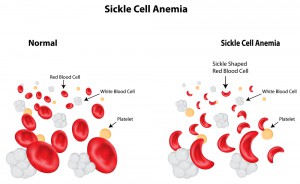
Sickle cell anemia is the most common genetic disease in the African-American community about 2 in 1000 babies will inherit the disease from their parents. Sickle cell anemia also occurs in the Mediterranean, the Middle East, India, and the Far East, although much less commonly. Beginning in childhood, sickle cell patients get episodes of bony pain caused by blood sickling in bones and organs. Other complications include serious pneumonia, bone marrow failure, kidney disease, strokes, leg ulcers, and, for men, a painful erection known as priapism.
Inherited genes are responsible for sickle cell anemia. Genes are our bodies DNA chemicals that allow us to inherit physical features such as hair and skin color, but they also cause genetic diseases such as sickle cell anemia. To inherit sickle cell disease, a baby must get two sickle genes? one from each parent. Parents can pass the gene to their children unknowingly, since they may carry the gene without any symptoms. In the African-American community about 1 in 10 people are silent carriers of the sickle cell gene.
A couple planning to have children can be tested to determine the child’s risk of inheriting sickle cell anemia. If both parents have sickle disease, all of their children will be born with sickle cell anemia. If one parent has sickle disease and one is a silent carrier, odds are one in two the child will have sickle disease. If both parents are silent carriers, odds are one in four the child will inherit sickle disease. If one parent is not a silent carrier, the children cannot get sickle cell disease, although a child may become a silent carrier. A couple at risk for having a child with sickle cell anemia can get fetal testing in the first trimester of pregnancy.
A patient with sickle pain crisis is treated with pain medications, and is sometimes given oxygen, intravenous fluids, or a blood transfusion. A patient with severe pain crisis with lung complications may need removal of sickle blood and replacement with regular blood. Those with severe sickle disease can decrease pain crises by going on a drug called hydroxyurea. Research is promising on using bone marrow transplant to replace the defective gene with a normal one.
Patients with sickle cell anemia are living longer than ever before, and exciting developments promise to continue this trend.

